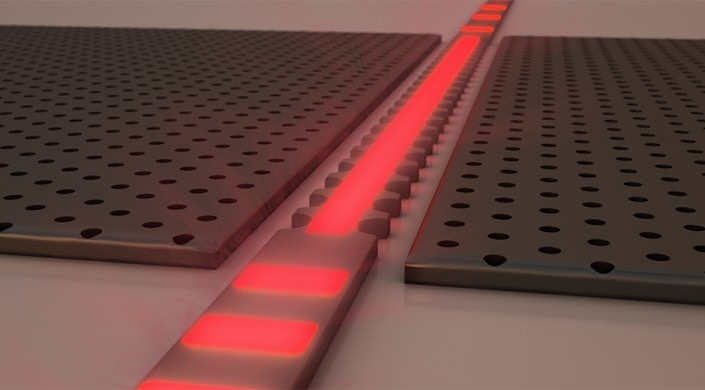Oct 10 2017
The first on-chip metamaterial with a refractive index of zero was developed by Researchers at the Harvard John A. Paulson School of Engineering and Applied Sciences (SEAS) in 2015. This meant that the phase of light could be stretched infinitely long.
 A zero-index waveguide stretches a wave of light infinitely long, creating a constant phase throughout the wire. (Image courtesy of Second Bay Studios/Harvard SEAS)
A zero-index waveguide stretches a wave of light infinitely long, creating a constant phase throughout the wire. (Image courtesy of Second Bay Studios/Harvard SEAS)
The metamaterial signified a new technique to regulate light and was a vital step forward for integrated photonic circuits, which use light instead of electrons to perform a wide range of functions.
Currently, SEAS Researchers have advanced that technology by creating a zero-index waveguide compatible with existing silicon photonic technologies. In doing so, the team noticed a physical phenomenon that is typically unobservable — a standing wave of light.
The study has been published in ACS Photonics. The Harvard Office of Technology Development has filed a patent application and is seeking commercialization opportunities.
When a wavelength of light travels through a material, its crests and troughs get stretched or condensed, based on the properties of the material. How much the crests of a light wave are condensed is stated as a ratio known as the refractive index — the higher the index, the more condensed the wavelength.
When the refractive index is decreased to zero, the light no longer acts as a moving wave, moving through space in a series of crests and troughs, otherwise referred to as phases. Instead, the wave is stretched substantially long, producing a constant phase. The phase oscillates only as a variable of time, not space.
This is stimulating for integrated photonics because a majority of optical devices use interactions between two or more waves, which need to propagate in sync as they travel through the circuit. If the wavelength is substantially long, matching the phase of the wavelengths of light is not a problem, as the optical fields are the same universally.
But after the preliminary 2015 discovery, the research team hit a catch-22 situation. Since the team used prisms to test whether light on the chip was certainly infinitely stretched, all of the devices were constructed in the shape of a prism. But prisms are not particularly beneficial shapes for integrated circuits. The team sought to build a device that could plug directly into current photonic circuits and for that, the most useful shape is a straight wire or waveguide.
The Researchers — led by Eric Mazur, the Balkanski Professor of Physics — constructed a waveguide but, without the aid of a prism, had no easy way to demonstrate if it had a refractive index of zero.
Then, Postdoctoral Fellows Orad Reshef and Philip Camayd-Muñoz had an idea.
Typically, a wavelength of light is too small and oscillates too rapidly to measure anything but an average. The only way to really see a wavelength is to unite two waves to generate interference.
Visualize strings on a guitar, pinned on either side. When a string is plucked, the wave moves through the string, hits the pin on the other side, and gets reflected back — making two waves traveling in opposite directions with the same frequency. This kind of interference is termed as a standing wave.
Reshef and Camayd-Muñoz applied the same concept to the light in the waveguide. They “pinned-down” the light by shining beams in opposite directions via the device to form a standing wave. The separate waves were still oscillating rapidly but they were oscillating at the same frequency in opposite directions, meaning at specific points they canceled each other out and other points they added together, making an all light or all dark pattern. And, because of the zero-index material, the team successfully stretched the wavelength large enough to see.
This perhaps was the first time a standing wave with infinitely-long wavelengths has ever been observed.
“We were able to observe a breath-taking demonstration of an index of zero,” said Reshef, who recently accepted a position at the University of Ottawa. “By propagating through a medium with such a low index, these wave features, which in light are typically too small to detect directly, are expanded so you can see them with an ordinary microscope.”
This adds an important tool to the silicon photonics toolbox. There's exotic physics in the zero-index regime, and now we're bringing that to integrated photonics. That's an important step, because it means we can plug directly into conventional optical devices, and find real uses for zero-index phenomena. In the future, quantum computers may be based on networks of excited atoms that communicate via photons. The interaction range of the atoms is roughly equal to the wavelength of light. By making the wavelength large, we can enable long-range interactions to scale up quantum devices.
Philip Camayd-Muñoz, Postdoctoral Fellow, Harvard University
The research paper was co-authored by Daryl I. Vulis, Yang Li and Marko Loncar, Tiantsai Lin Professor of Electrical Engineering at SEAS. The research was supported by National Science Foundation and was performed partly at the Center for Nanoscale Systems (CNS).